Reviews
PREACHERS, politicians, and other public speakers know that a story is often the best way to get a point across to their listeners. In his itinerant ministry, Jesus was no exception. Some of his most important teaching was contained in stories—parables. Yet often we do not take them seriously enough to seek what he was really saying. Two thousand years of Christian theology has also obscured his original intent, often by considering them to be allegories rather than stories.
In that process, anti-Jewish stereotypes and prejudices have too often come to dominate the interpretation of the parables. Any villain is seen as representing Judaism, while the hero or victim represents the church—and, of course, in this framing God is on the side of the church. This often-unconscious bias affects how we read and understand the story and obscures Jesus’ message.
Professor Amy-Jill Levine, in Short Stories by Jesus, aims to correct that. As a Jewish New Testament scholar teaching at a Christian divinity school, she is uniquely situated to place Jesus and his teaching in their historical and cultural context. Jesus was a first-century Jew speaking to other first-century Jews. If we do not understand that starting point, we cannot understand Jesus or his stories. In an introduction not to be skipped, she points out that the parables often echo themes that appear elsewhere in Jesus’ teachings: economics, relationships, and, most important, prioritizing life in expectation of the coming kingdom of God. To make his point, he uses common, everyday examples of real-life characters and situations his audience would recognize.
IN 1973, IMMEDIATELY following the Yom Kippur War, I watched the movie Exodus. I was so swept up by Leon Uris’ depiction of the Zionist struggle that I wrote in my journal, “The U.S. should do everything it can to defend the state of Israel!”
Two years later, I read a history of the Arab-Israeli conflict in a serialized encyclopedia of World War II. It transformed me into an impassioned defender of Palestinian rights. Clearly, the historical narrative one accepts is critical to determining how a conflict is understood.
Jo Roberts’ book Contested Land, Contested Memory: Israel’s Jews and Arabs and the Ghosts of Catastrophe challenges the nationalist mythologies of both Israelis and Palestinians, peoples largely in denial of each other’s histories. With exhaustive research and numerous personal interviews, Roberts has created a book that is both sensitive to and challenging for partisans of either side.
Roberts begins with the story of an Israeli Jew whose memories of idyllic childhood vacations in a particular village are shattered when she learns from a Palestinian boyfriend that his family was displaced from that village by Israeli soldiers in 1948. Roberts goes on to offer a history of Zionism that is not without its share of heartbreak. From persecution in Catholic Spain to the Dreyfus affair in France and government-sanctioned pogroms in Russia, she reminds us of the prevalence and ferocity of anti-Semitism, which led many to join the movement to create a Jewish state in Palestine. She includes a report to President Truman about 250,000 Holocaust survivors, who in late 1945 were still confined in former slave labor and concentration camps because no country, including the U.S., would accept them as refugees. Roberts makes a convincing case that many Jews went to Palestine because they literally “had nowhere else to go.”

IN THE U.S., mention of “aging in community” might conjure up images of weathered faces in nursing homes and snowbirds in South Florida. And yet, as increasing numbers of Americans reach the golden years—and do so in an uncertain economy—so do the array of scenarios for those growing older. Award-winning journalist Beth Baker traveled across the U.S. to document the possibilities in her latest book, With a Little Help from Our Friends: Creating Community as We Grow Older.
Some of her findings aren’t so surprising. Baby boomers have a stronger desire for independence than did their predecessors, and they aren’t keen on being tagged “elderly.” In fact, they generally see themselves in a different cohort than those born just prior to the boom.
Whether you’re in one of the aforementioned age groups or a diligent millennial thinking way ahead, Baker shows that imagining how you’ll one day balance independence with human connection in your older years doesn’t have to be daunting.
“That we can raise this question is remarkable. Never before have older people, often through their own imagination and determination, had real options from which to choose,” she writes.
CORNEL WEST and Christa Buschendorf have collaborated to bring forth a powerful look at the visionary legacies of 19th- and 20th-century African-American leaders. Black Prophetic Fire consists of six conversations between West and Buschendorf, each one focusing on a different black prophetic figure: Frederick Douglass, W.E.B. Du Bois, Martin Luther King Jr., Ella Baker, Malcolm X, and Ida B. Wells. In the book, West displays his wealth of knowledge and understanding of those prominent historical black icons and their movements.
For West, U.S. society has arrived at a pivotal point. He sees the “black embrace of the seductive myth of individualism in American culture” as reason enough to ask tough reflective questions such as, “Are we witnessing the death of black prophetic fire in our time?” and “Have we forgotten how beautiful it is to be on fire for justice?”
West is known as an intellectual and activist who loathes the unfair treatment of people anywhere, regardless of their race, gender, sexual orientation, or religious creed. His message of love, particularly for the younger generations, becomes the undertone of this book. Throughout the years, the black prophetic tradition has seen a decline in exemplars of integrity. West presents the conversations he had with Buschendorf as a history lesson and a call to younger generations to not let this tradition fizzle out.
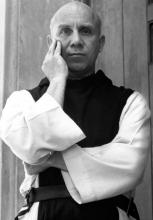
WHILE NOT HERE in person for the celebration of his 100 birthday on Jan. 31, Thomas Merton is certainly present in spirit through the extraordinary number of volumes about and even by him being issued to mark the anniversary—a splendid opportunity for readers to acquaint or reacquaint themselves with the monk often considered the most significant American Catholic writer of the past century.
Perhaps the best place to start is Messengers of Hope: Reflections in Honor of Thomas Merton, edited by Gray Henry and Jonathan Montaldo (Fons Vitae), a collection of more than 100 reflections by monks and activists, scholars, filmmakers, and poets, and Christian, Jewish, and Buddhist practitioners on the significance of Merton for their own lives. Some of the contributors are well known—Joan Chittister, John Dear, Jim Forest, James Martin, Richard Rohr, Huston Smith; others are well known in Merton circles; some are younger voices who one day may become well known but already have valuable insights as to how Merton continues to speak to the needs and hopes of the contemporary world. This is a rich compendium of personal stories that is a delight to dip into or to read straight through.

POLICE BRUTALITY, the Affordable Care Act, climate change: When people with differing convictions on issues such as these come together for conversation, some prefer to first set aside the issues and focus on building relationships, while others want disagreements front and center. In his book I Beg to Differ: Navigating Difficult Conversations With Truth and Love, Biola University communications professor Tim Muehlhoff says relationship and honesty are necessary for progress to be made.
“If every conversation we have with others is about the issues that divide us, the intensity will hurt the communication climate,” he writes.
For example, he offers the hypothetical story of an evangelical Christian who wants to share his faith with a Muslim co-worker. Over lunch, the colleagues take time to learn about each other’s differing religious convictions, but the conversation doesn’t invade their work relationship. Back at the office, they return to their easygoing, day-to-day relational habits.
It’s a mistake to begin conversations by trying to convince others of our position, Muehlhoff says. It is better to listen with a sincere desire to understand what the other person believes and why they believe it.
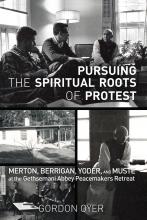
IN NOVEMBER 1964, as the long Cold War heated up again, this time in Vietnam, Trappist monk Thomas Merton set forth a koan to 14 peacemakers: “By what right do Christians protest?” For three days, these activists and theologians—famously uniting Catholic and Protestant faith traditions—met with Merton in the Kentucky hills, grappling with how and why Christians should resist the violence of war.
Historian Gordon Oyer has re-created this meeting so pivotal to the peace movement and—most important—assessed its meaning for our time. The historic retreat is meticulously sourced with detailed textual analysis of the presenters at the retreat and the writers who influenced them. Particularly impressive is the lucid summary of the era and the delicacy and respect with which the author treats cultural and doctrinal differences among the participants.
Ecumenism in peace work is thankfully common today, but in the early ’60s the blending of faith traditions at the retreat was groundbreaking. Even more revolutionary were the two Masses the group celebrated together, with Jesuit priest Dan Berrigan presiding, everyone in the group receiving communion, and John Howard Yoder, a Mennonite theologian, preaching at the second liturgy. (Both practices were proscribed at the time.)
Attendees included Phil Berrigan, later one of the creators of the Plowshares actions for nuclear disarmament, and A.J. Muste, dean of the U.S. peace movement at the time, with years of experience in War Resisters League, the Committee for Nonviolent Action, and the Fellowship of Reconciliation (FOR). FOR’s Paul Peachey and John Heidbrink were instrumental in initiating and organizing the retreat, although neither of them could attend in the end. (Neither could two other invitees—Bayard Rustin and Martin Luther King Jr.)
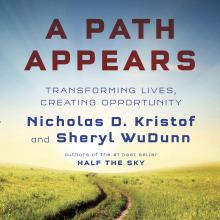
IT’S EASY to lose heart when tackling the painful challenges we live with—poverty, racism, violence, sex trafficking. We volunteer and donate our time and money, but do those efforts really make a difference?
Nicholas D. Kristof, a New York Times columnist, and Sheryl WuDunn, a former Times reporter who works in finance, had the same question; A Path Appears is the result of their investigation. The husband-and-wife team canvassed the giving world, interviewing socially minded people working as individuals or in community with nonprofits, corporations, for-profit organizations, and everything in between. Turns out millions of lives are being transformed next door and across the globe—including our own.
Bernard Glassman, for example, is an aeronautical engineer who wanted to do something about homelessness. After researching the issue for six months, he decided jobs were the most urgent need and started Greyston Bakery in Yonkers, N.Y., a for-profit company whose mission is to employ homeless men and women.

INSIDE TOWN HALL, New York’s legendary concert venue, the dusty twang of a harmonica slices through the low din of the crowd filling the 1,500-seat auditorium. Most are likely here for the headliner, singer-songwriter Patty Griffin, who will take the stage after this, a performance by her opening act, Parker Millsap.
The bluesy riffs from Millsap’s harmonica are intense, long and wailing, before fading into the slow, dirty licks of a slide guitar. Then a voice, old and soulful, throbs through the room, crying out the first line of the old gospel standard “You Gotta Move” and shocking many in the audience, residents of a city where very little is shocking. You can see the wave of surprise move like a serpent across the room, with people turning to their companions, eyebrows raised and a whisper on their lips.
It’s the age that gets them—the man standing at center stage, flanked by two bandmates and looking like a rockabilly idol, with his gelled quiff and rolled-up shirt sleeves, isn’t the 60-year-old blues singer he sounds like. No, he is baby-faced, young—barely even 21—and yet he’s pulling this song from some secret, battered place inside him that’s far older than his years, and matching it with a sensual intensity that sizzles in the audience. By the time Millsap allows the last note from his weathered voice to fade, he has commanded the undivided attention of one of the world’s toughest crowds.
And they are raring for more.

CHEF IS A small-budget film with an all-star cast and artful storytelling. Jon Favreau, who also directed Iron Man, stars in his own film as a head chef named Carl Casper at an acclaimed restaurant in Los Angeles. Casper is left in a vocational tailspin after a scathing review and a public meltdown. He loses his inspiration and finds himself in an existential crisis.
In Chef Casper’s quest to recover his culinary mojo, he takes a trip to Miami and buys a used food truck. The film plays on the power of relationships in a messy, winding, but authentic path. Chef Casper’s community—his ex-wife, his son, and his best friend—are invited into the one thing Casper loves to do, demonstrating how community, at its best, can propel us on the way we should go.
Each truck stop on the journey back to California fills Chef Casper with new vision and adds distinctive ingredients. He makes his way to once again bring beauty and flourishing back to his street corner of the world.
My small group at church watched Chef together and bonded over it. We explored themes of vocation—how we can contribute to flourishing through the distinctive things “we’re good at.” And how activism isn’t just about waving the proverbial picket sign; it also can be about loving what we do with great friends.
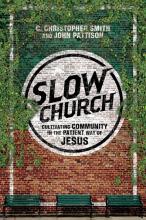
HERE’S WHAT Slow Church is not: A how-to manual with five easy steps to make your congregation more thoughtful. A celebration of how using the word “community” often on your church website will multiply your pledge and attendance numbers. An ode to really, really long worship services.
Rather, Slow Church explores being church in a way that emphasizes deep engagement in local people and places, quality over quantity, and in all things taking the long view—understanding individuals and congregations as participants in the unfolding drama of all creation. Authors C. Christopher Smith and John Pattison are self-proclaimed “amateurs,” insofar as they are writers-editors and lay leaders, not professional pastors, theologians, or congregational consultants. But this book is richly informed by their experience in their own church contexts (Englewood Christian Church in a gritty neighborhood in Indianapolis for Smith; an evangelical Quaker meeting in small-town Oregon for Pattison), conversations with other church communities, and close reading of classic and contemporary literature on culture, Christian community, scripture, and spirituality
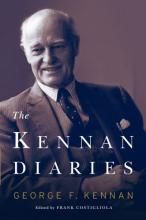
THE KENNAN DIARIES, carefully edited by Frank Costigliola, a University of Connecticut historian, covers an amazing and sometimes disturbing 88-year period of personal journal-writing by George F. Kennan, who became the most famous diplomat-intellectual of the 20th century.
Born in 1904 (he died in 2005) Kennan, a Milwaukee native, grew up in an upper-class Scotch-Irish Presbyterian family with three older sisters and a father who was a tax attorney.
After graduating from Princeton, Kennan became a Foreign Service officer with the State Department, eventually serving in posts throughout Europe. But Kennan’s first love was Russia. He wrote in his diary that “he had a mystical connection to Leningrad, as though he had once lived there.” He was offered a three-year university stint in Berlin by the State Department—Kennan’s boss wanted him to be educated like a pre-Bolshevik Russian gentleman. Kennan’s grasp of the Russian language and history became exceptional. Together with his prodigious analytical skills, it would be the foundation of his brilliant career.
After 20 years abroad, Kennan fired off his famous 5,540-word “Long Telegram” on Feb. 22, 1946, from Moscow to Washington. Soon afterward, in July 1947, he wrote another piece in Foreign Affairs under the byline “X.” In the two pieces he said that the Soviets under Stalin would try aggressively to expand, but that the U.S. should not employ military means to stop them. Instead, Kennan advocated “containment,” heavily monitoring the Russians with hard-headed diplomacy and tough talk. He also stated that the Soviet Union would eventually self-destruct.
AMID WORRIES about a new Cold War, of standoffs with old enemies and confrontations with new ones, Harvard professor Elaine Scarry’s latest book is a chilling reminder of the doom our presidentially controlled nuclear arsenal can unleash upon the world. Early on, she reminds us that President Nixon told reporters, “I can get on the telephone and in 25 minutes 70 million people will be dead.”
This boast illustrates Scarry’s thesis: We live in a thermonuclear monarchy, where one person—the U.S. president—can destroy the world. Nuclear doom is an accident waiting to happen, and she reviews a number of barely publicized near misses.
But she sees a solution at hand—the U.S. Constitution, specifically both Article I, Section 8, which says that Congress alone can declare war, and the Second Amendment. The text of the latter reads: “A well regulated militia being necessary to the security of a free state, the right of the people to keep and bear arms shall not be infringed.” (Emphasis added.) Scarry argues that the amendment mandates a second level of citizen consent to war, a further brake to executive power, even after Congress has given its approval—that the writers of the Constitution intended that before the U.S. engaged in any war the people would have to consent to join a militia, a form of collective participation in the decision for war. According to Scarry, our out-of-ratio nuclear weapons stockpile, ready to launch at the command of a single person, has negated the Constitution-mandated chain of accountability and decision-making and is therefore illegal.
FAITH-ROOTED Organizing: Mobilizing the Church in Service to the World outlines a theological cartography of social change. In this critical intervention, Alexia Salvatierra and Peter Heltzel reimagine—and as a necessary consequence, rechart—the landscape of vision, action, and strategic planning needed for social change.
Full disclosure: I have attended several trainings conducted by the co-authors. Indeed, the dual authorship of the text is a principal strength. Faith-Rooted Organizing blends the voice of an evangelical-activist theologian in Heltzel with the homespun profundity of a seasoned pastor and campaign organizer in Salvatierra. The authors delight readers with complementary writing styles: Heltzel speaks through theological propositions, interpolated intermittently with jazz references and theological punch lines; Salvatierra communicates through proverbs, organizing anecdotes, poignant biblical passages, and narrative side notes.
The result is a well-argued and accessible text that should resonate from the seminary to the sanctuary. Their driving thesis is that faith communities, especially Christian ones, should organize for social change in a way that is rooted and guided by the stories, symbols, sayings, and scriptures of our faith. Faith-Rooted Organizing functions as an instruction manual on effective advocacy while providing a theological rationale and vocabulary for a vocation marked by tremendous victories and colossal failures, breakthrough partnerships and fragmented coalitions, glimpses of beloved community and portraits of democracy stillborn.

WHAT IS THE relationship between one’s religious beliefs and one’s economic and political views? Are some religious beliefs more “American” than others?
These questions come to mind in reading Samuel Gregg’s Tea Party Catholic: The Catholic Case for Limited Government, a Free Economy, and Human Flourishing. Gregg suggests that religion directly informs—or should inform—our understanding of political and economic issues and that religious, economic, and political liberty are inextricably bound. A perceived or real “attack” on one, he contends, is an attack on all.
Gregg is director of research for Acton Institute, a libertarian think tank whose core principles seek the “integrating [of] Judeo-Christian truths with free market principles.”
In Tea Party Catholic Gregg writes of a “new type of Catholic American” who is grounded in a “dynamic sense of orthodoxy” but whose “Americanness” is defined by faith in free market principles. Tea Party Catholic details how free market principles and a view of government “with clear but constrained economic functions” have, Gregg argues, not only deep roots in U.S. political history but also in Catholic tradition. Thereby, he suggests, any U.S. Catholic differing in his or her economic and political beliefs has neither a proper understanding of the United States’ founding nor of the teachings of the Catholic Church.
Gregg’s attempt to sacralize libertarianism is not consistent with Catholic doctrine: It runs counter to stated positions of the Vatican and the majority of Catholic theologians and economists. At a recent conference at The Catholic University of America one of Pope Francis’ advisers, Cardinal Oscar Rodríguez Maradiaga, said that in commenting on free market and libertarian influences on our global economy, Pope Francis gave a “sharp prophetic verdict: ‘This economy kills.’”
YOU DON’T HAVE to be an environmentalist to wonder about technology. Will it be our great savior or another thorn in the flesh, another opportunity to hear Thoreau’s lament about the tendency of humans to “become the tools of their tools”?
This excellent collection of prayers and worship materials, From the Psalms to the Cloud, helps us understand the tool of technology. It is a very green book while also being useful. It is green because it gives us a way out of the totalitarian world of the market and into a world that we make with words.
Just about everybody is on the other side of the “time famine” and the “trust famine” and deep into digital and connectivity overload. By time famine I mean the pervasive sense that there is not enough time to do what we want, so subjugated is our time to technology, forms, and robotic requests for information. By trust famine I mean all that time we spend worrying about time and wondering if somebody else is in charge. Are we in charge of our tools and our time or are our tools and time in charge of us?
In this optimistic book, the prophets arrive. Mankin and Tirabassi ask the right question: Can a technology devoted to advertising be useful to spirituality? They answer with a careful yes, taking us on the long road from the Psalms to Twitter, by way of “vintage wine in vintage wineskins, uncorked.” These two writers gather the wisdom of dozens of beautiful writers of prayers and liturgies and show us a way to go deep digitally. Whether they are praying for energy that will “deeply change all of our clocks,” or for the return of the time when churches giving sanctuary for immigrants will become again “dusty places with pews,” or in any of John Dannon’s exquisite doxologies for the natural and ecclesiastical seasons, or encouraging us to “spend a day saying nothing that doesn’t need saying.” The prayer topics move through addiction to pregnancy to a ritual for quitting a job. What a great ask this is for those confused or overdone with technology: We pray “for a trap door when we hit rock bottom.”
FORGIVENESS IS wholeness, Nobel Peace Prize winner Archbishop Desmond Tutu and his daughter, Anglican minister Rev. Mpho Tutu, write in their newest collaboration,The Book of Forgiving. Scientific research shows that forgiveness has the power to transform us in spiritual, emotional, and even physical ways. That evidence is paired with the Tutus’ collective experience in counseling, studying, and teaching and their personal stories about the difficulty of forgiving. Archbishop Tutu writes about learning to forgive his abusive father. Mpho, who writes about learning to forgive the man who murdered her housekeeper in her home, is pursuing a PhD in the topic of forgiveness.
The book lays out some simple but critical truths: Everyone can be forgiven. Everyone deserves forgiveness. You must be willing to forgive. Forgiveness is not a weakness, nor a luxury. Forgiving others is a way to practice forgiving yourself. Through forgiveness, we all become whole again. Unconditional forgiveness is an act of grace that frees all parties from further indignity, and from self-blame and corrosive hatred.
The path to forgiveness seems simple enough when you can navigate it in four easy-to-follow steps: Tell the story. Name the hurt. Grant forgiveness. Renew or release the relationship. The path is also—sorry—a bit pedestrian. That doesn’t mean the route map isn’t useful. But the book will be most applicable if you have struggled to forgive or feel that even contemplating forgiveness is an impossible burden weighing heavy on your heart and soul. If you’re carrying a load you can’t seem to gracefully shrug off or leave by the side of the road, the Tutus can help you chart the course.
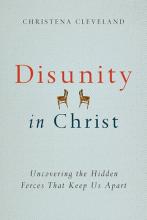
OVER THE PAST 2,000 years, Christians have found myriad ways to divide the body of Christ. We are now more divided than ever, with more than 40,000 Christian denominations worldwide. Perhaps, in this context, we are asking the wrong questions. Do we really understand God’s desire for the church to be one? Do we as individuals have a yearning for the unification of the body of Christ? Why do we create the divisions we create? Why do we maintain the divisions that already exist? How can we break through these barriers to heal a broken church?
Christena Cleveland sets out to answer all of these questions and more in her latest book, Disunity in Christ. Cleveland is a young, energetic, and brilliant teacher, speaker, and researcher in the fields of social psychology and faith and reconciliation. For those concerned with reconciliation in the church, which should be all of us, hers is a voice to take seriously.
In Disunity, Cleveland quickly breaks the ice by poking fun at herself and by pointing to her own personal prejudices and biases that have led to her categorically labeling fellow brothers and sisters in Christ as either a “right Christian” or “wrong Christian.” The reader is immediately able to connect with her and realize the ways in which we have created division in our own lives, whether because of race, gender, orientation, education, location, socio-economic status, theology, or political affiliation. It also becomes apparent why we prefer our homogenous groups.
MUSIC IS OFTEN regarded and consumed as something that fills a space—the chords of an organ resounding off the walls of a sanctuary, the beats of a drum circle riding on the breeze through a park, the harmonies of an orchestra flowing from my headphones into my ears as I write. Music even transcends physical spaces to permeate the heart and the soul with emotion.
In Music as Prayer, pastor and musician Thomas H. Troeger invites the reader to cherish and engage in music as an act of prayer. Taking into account the metaphorical, scientific, and practical aspects of music-making, Troeger illustrates the power of music to not only fill a space but to also clear a way for meaning and creativity. Building upon Henry Ward Beecher’s metaphor of a boat stuck on the shore, Troeger describes how the “mighty ocean-tone” of a church organ brings the “tide” needed to lift up the members of the congregation and set them free from the shore.
In what Troeger calls a “dialogic process,” music lends rich metaphors to language and changes the effect of language upon the listener. The same song played in two distinct styles can convey two completely different sets of emotions.
From the ancient flute invented 35,000 years ago to today’s smartphone streaming songs on demand, music has occupied a central part of the human story. The mystery of music lies in the way that sound waves can blend into melodies that speak directly to the human yearning for wholeness. Creating space for both celebration and lament, music has the capacity to hold opposing emotions in the same breath. Music can provide release from suppressed inner tension and give voice to even the most unspeakable emotions.
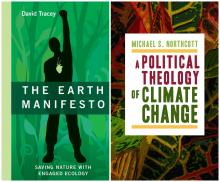
CLIMATE CHANGE and its accompanying issues are mammoth topics. David Tracey’s The Earth Manifesto and Michael S. Northcott’s A Political Theology of Climate Change are ambitious and sound theoretical and practical treatments.
With different faith backgrounds, each brings to the task the urgency of the moment. Tracey is a Vancouver urban ecologist, a fiction and nonfiction writer, a writing teacher, and an avid housing co-op dweller with his wife and two school-age children. He has spearheaded several community garden co-ops. Northcott is a priest in the Church of England and a University of Edinburgh social ethicist who has written on understanding space and its sacred sharing, urban ministry and theology, and now this, his third book on climate change.
Tracey’s The Earth Manifesto dives right into the ecological mandates of our time and place. It gently and consistently employs an implicit Buddhist perspective to offer concise chapters—really a set of tools—to name, address, engage, and sustain a meaningful citizens’ involvement. These are expressed in two parts: three big ideas and three big steps. The ideas consist of “Nature Is Here,” “Wilderness Is Within,” and “Cities Are Alive.” Tracey’s three big steps are “groundtruthing”—engaging deeply in a place to shape one’s environmental efforts; political advocacy; and building a community to help spread a campaign for change.
Two concepts stand out vividly. Tracey’s explanation of groundtruthing conveys the need to test a theoretical perspective by getting right on the ground to verify its potential in the concrete. One intuits incarnational theology here. He also affirms the nature of engagement from its French origins to mean “someone passionately committed to a cause”: pledged, dedicated, or devoted. For me this summons the discipline of spirituality in the service of social justice.